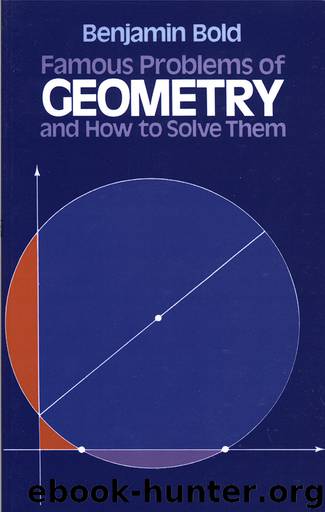Famous Problems of Geometry and How to Solve Them by Benjamin Bold

Author:Benjamin Bold
Language: eng
Format: epub
Publisher: Dover Publications
Published: 1969-06-26T16:00:00+00:00
PROBLEM SET VII–A
1. Construct regular polygons of 2m sides where m equals (a) 2. (b) 3. (c) 4.
2. Construct a regular polygon of 3·2m sides where m equals (a) 0. (b) 1. (c) 2.
3. Assuming that regular polygons of 3 sides and 5 sides can be constructed, show how to construct a regular polygon of 15 sides by finding two integers k and l such that 3k + 5l = 1. How would you then construct a regular polygon of 30 sides?
4. According to what you have learned thus far, is it possible
(a) to construct a regular polygon of 3·3 or 9 sides?
(b) to construct a regular polygon of a + b sides if regular polygons of a and b sides can be constructed, and a and b are relatively prime? Try to prove your conjecture.
For more than 2,000 years the problem of dividing a circle into equal parts remained as left by the ancient mathematicians. Despite the fact that such eminent mathematicians as Fermat and Euler worked on the problem, no further progress was made until the end of the eighteenth century, when Gauss solved the problem completely in 1796.
E. T. Bell in his Development of Mathematics states “The occasion for Gauss’ making mathematics his life work was his spectacular discovery at the age of nineteen concerning the construction of regular polygons by means of straight edge and compasses alone.” Prior to his discovery Gauss had been considering a career in Philology. D. E. Smith in his History of Mathematics quotes Gauss’ own record of his discovery.
“The day was March 29, 1796, and chance had nothing to do with it. Before this, indeed, during the winter of 1796 (my first semester at Gottingen), I had already discovered everything relating to the separation of the roots of the equation, (xp − 1)/(x − 1) = 0 into two groups. After intensive consideration of the relation of all the roots to one another on arithmetical grounds, I succeeded during a holiday at Braunschweig, on the morning of the day alluded to (before I got out of bed,), in viewing the relation in the clearest way, so that I could immediately make application to the 17 sides and to the numerical verifications.”
Courant and Robbins in their book What Is Mathematics? state “He [Gauss] always looked back on the first of his great feats with particular pride. After his death a bronze statue of him was erected in Göttingen; and no more fitting honor could be devised than to shape the pedestal in the form of a regular 17-gon.” Why a regular polygon of 17 sides will become clear later.
Let us now examine Gauss’ remarkable achievement. At the beginning of the chapter we indicated that the Greeks could construct a regular polygon of n sides, if n is of the form , when P1 = 3 and P2 = 5 and r = 0 or 1. In Problem Set VII–A, you were asked to construct a regular polygon of 3 sides, but not of 5.
Download
This site does not store any files on its server. We only index and link to content provided by other sites. Please contact the content providers to delete copyright contents if any and email us, we'll remove relevant links or contents immediately.
| Applied | Geometry & Topology |
| History | Infinity |
| Mathematical Analysis | Matrices |
| Number Systems | Popular & Elementary |
| Pure Mathematics | Reference |
| Research | Study & Teaching |
| Transformations | Trigonometry |
Modelling of Convective Heat and Mass Transfer in Rotating Flows by Igor V. Shevchuk(6345)
Weapons of Math Destruction by Cathy O'Neil(6069)
Factfulness: Ten Reasons We're Wrong About the World – and Why Things Are Better Than You Think by Hans Rosling(4611)
Descartes' Error by Antonio Damasio(3180)
A Mind For Numbers: How to Excel at Math and Science (Even If You Flunked Algebra) by Barbara Oakley(3173)
Factfulness_Ten Reasons We're Wrong About the World_and Why Things Are Better Than You Think by Hans Rosling(3152)
TCP IP by Todd Lammle(3089)
Applied Predictive Modeling by Max Kuhn & Kjell Johnson(2970)
Fooled by Randomness: The Hidden Role of Chance in Life and in the Markets by Nassim Nicholas Taleb(2957)
The Tyranny of Metrics by Jerry Z. Muller(2946)
The Book of Numbers by Peter Bentley(2865)
The Great Unknown by Marcus du Sautoy(2605)
Once Upon an Algorithm by Martin Erwig(2533)
Easy Algebra Step-by-Step by Sandra Luna McCune(2530)
Lady Luck by Kristen Ashley(2490)
Practical Guide To Principal Component Methods in R (Multivariate Analysis Book 2) by Alboukadel Kassambara(2441)
Police Exams Prep 2018-2019 by Kaplan Test Prep(2435)
All Things Reconsidered by Bill Thompson III(2320)
Linear Time-Invariant Systems, Behaviors and Modules by Ulrich Oberst & Martin Scheicher & Ingrid Scheicher(2298)
